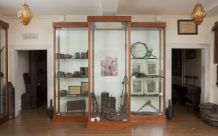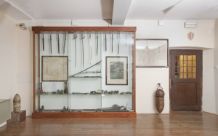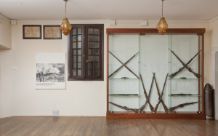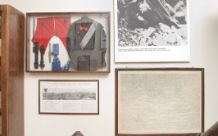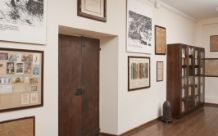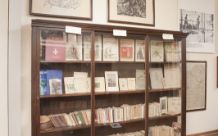The Museum and its history Read on...
In order to give the current visitor an idea of how the Museum was originally set up in the period from 1938 to 2012, we propose a sort of virtual tour of that layout. In doing so, we also intend to pay tribute to the objectives that have driven Marson and many other donors, but also the local and state authorities of that era, for very carefully constructing a Museum so rich in relics and materials.
Until the recent, fundamental restructuring, the Museum's layout was composed of a number of rooms, divided into three floors and dedicated to the local heroes of the Great War, underlining the intention to enhance the glories of the city. The first few rooms on the ground floor (named after G. Costantini, E. Artico and C. De Carlo) mainly contained war relics, from helmets to gas masks, rifles to iron clubs, field telephones to cartridge cases. The arrangement reflects a collector's expertise well displayed in the Museum, that has been enriched over time by successive donations.
Furthermore, the materials collected, displayed in an inevitably disorganised manner (due to the lack of available display area with respect to the large number of exhibits) gave the opportunity to emphasise the theme of material culture in the trenches, to which the historiography of the last few decades has devoted growing attention.
Also, they were the main inspiration behind the new layout, designed by Lorenzo Greppi, who created a sort of "ultimate" trench on the ground floor. No longer divided into small rooms, the floor exhibits some models of objects used by soldiers to fight, but also to survive, communicate, and pass the time.
Starting from the ground floor rooms, the previous layout of the Museum also revealed its strongly propagandist contents, which were conceived during the Fascist era. Indeed, in addition to the various reproductions of the famous "victory bulletin", some famous phrases were displayed on the walls, voiced (or at least, so we wanted to believe) by equally famous individuals directly related to the war, but also by authoritative members of the Fascist regime, like the minister and former soldier Federzoni.
Next to the late propaganda on the myth of the Victory, numerous strictly speaking war propaganda documents were found on the ground floor: contemporary posters designed to highlight the profound difference between the good guys and the bad guys.
Going up to the first floor, we leave behind the military weapons to finally enter the field of propaganda and ideology. In the first room to the right (A. Franceschini room) a lot of very interesting material was collected, but at the same time it was barely usable and readable. I especially refer to the "newspapers of the trenches", mainly produced during the last year of the war by famous artists and intellectuals, whose aim was to tighten the grip on the army's morale on the Piave River, but to also provide some ways to pass the time. Next to the newspapers of the trenches, are numerous flyers that were dropped from Italian aeroplanes onto enemy lines. Written in several languages that were spoken by the soldiers and officers of the Austro-Hungarian army, the primary purpose of the flyers was to undermine the might of that composite military structure.
In the next room, named after B. Brandolini D'Adda, the layering of documentary materials was further highlighted. The "Battle" remained the centrepiece, exemplified in the exhibition in the big wooden showcases containing official military bulletins that reconstructed the sequence of events in a detailed and official manner. A giant poster also stood out in the room, depicting a photograph of the public ceremonies held in Vittorio Veneto in November 1938 to mark the twentieth anniversary of the Victory. The scene deserves an in-depth examination especially when compared with another photograph, displayed on the second floor, which depicted the tenth anniversary in 1928. While in that year the ceremony was focused on the Town Hall Square in the presence of a mixed and diverse crowd, composed of many citizens in civilian clothes, the giant poster of 1938 – the year when the Museum opened at its current location – showed the predominance of the military, with hundreds of flags in a square perfectly lined by rank. In the giant poster, inspired by a photograph taken from the roof of the Town Hall, the civilians, or rather the inhabitants of Vittorio Veneto, only appeared at the edges of the ceremony, dominated by the authorities and the military. By comparing these two images – made difficult by the chaotic overlapping of exhibition themes – reflections could be drawn on the consolidation of the regime in a militaristic sense and its adoption of the myth of the Victory as a cause for legitimacy of the very regime.
Still on the first floor, we enter the room named after E. and G. Sommavilla. Interspersed with many even recently acquired materials, including a number of engravings by influential artists of the post-Second World War period, with war as a general theme, two interesting documents were found. The first was a poster, issued by the Mayor of Sacile on 29 October 1917, during the military and civilian retreat that followed Caporetto. The poster urged people to remain calm, stay in their homes, and reassured them with a white lie that the retreat was, in fact, a normal tactical move to organise the battle front. No indication was given by the Museum curators about this document, which bears witness to the radical crisis that besieged the Italian army and civilian apparatus after the defeat of Caporetto.
A second interesting piece of documentary evidence, which should have been more clearly contextualised, was depicted by a model replica of the Montello plateau. Only a careful observer or an expert on military matters would have realised that it was a piece of work created by the Austro-Hungarians probably in preparation of the offensive of the so-called Battle of the Solstice (15-23 June 1918). It was the last Austro-Hungarian attempt to break down the battle front of the Piave River, and Montello was one of the targets of the attack. The model therefore was presumably used to study the plans of the attack.
The main theme in two of the three rooms on the second floor (named after A.Tandura and G. De Nardi respectively) was the invasion; a rich, incohesive collection of materials was displayed. It included mostly printed materials, but also exhibits illustrating a page of Venetian and Italian history, till now largely neglected. For one whole year, almost one million Venetians and Friulians had to endure a harsh occupation regime by Austro-Hungarian and German troops, who had reached the Piave River. The regime was characterised by the occupants' primary desire to exploit all the available resources of an area where almost only farmers remained, while a substantial part of its ruling class had found shelter behind the Italian lines.
On this subject, the two rooms displayed several orders issued by the occupational authorities to seize available resources, down to the dry leaves, and control people in all their movements, for example, by issuing mandatory ID cards for moving out of the district. Diaries written in that year were also present, as well as fragments from the bells destroyed by the armies in order to melt them and draw from them the bronze that was needed for the cannons. In addition, letters, faded photographs depicting military occupants, sometimes with civilians, small objects, which offered glimpses for analysing the extremely harsh conditions of the occupied civilians, not least the military occupants in 1917-1918.
The collection of papers published by the military authorities for soldiers (such as Die Front, which was printed in Vittorio Veneto) and for civilians alike is also valuable: the Gazzetta del Veneto [Veneto Gazette] with its entertaining weekly supplement Domenica della Gazzetta [Sunday Gazette], copying the graphics and contents of the very famous Domenica del Corriere [Sunday Courier].
There is an unknown object in the main room: a console or some kind of secular altar, made of bluish green Murano glass, richly ornate, with flags of some of the winning countries preserved under the glass.
The room in front of the one dedicated to the invasion was called "The Heroes". It displayed a small memorial in honour of the fallen and the heroes. There is a stele that stands out there on which all the names of the people of Vittorio who lost their lives in the war are transcribed. There are large photographs all around of the general commanders of the Italian and allied armies in 1918, and of some heroes. With its rhetorical hype this room clearly contrasted with the modest tone of the previous room, where materials related to the invasion were sedately displayed. On the other hand, the Heroes room was fully consistent with the celebratory perspective featuring the Museum as a whole in its 1938 layout.
The last room contains more photographic documents on the year of the invasion: women wrapped in heavy shawls waiting on the steps of the Town Hall, longing for a full passport; Austrian soldiers carelessly gathered around the firesite; phone lines that thicken on the makeshift telephone exchange of the Sixth Army command, in Vittorio Veneto. A group of boys armed, protagonists of a feat of arms on the Fadalto in the final days of the war. Finally, the photograph of some inhabitants, women and children, greeting the liberators: no grandiose embraces, no joy, but a resigned sadness prevailed on their haggard faces.
Gustavo Corni
